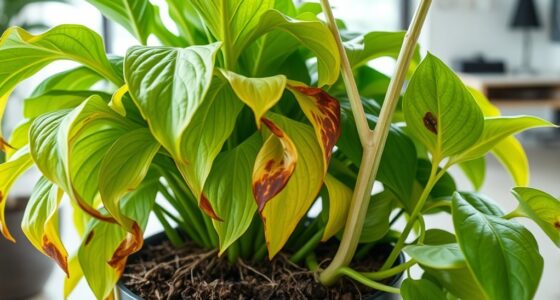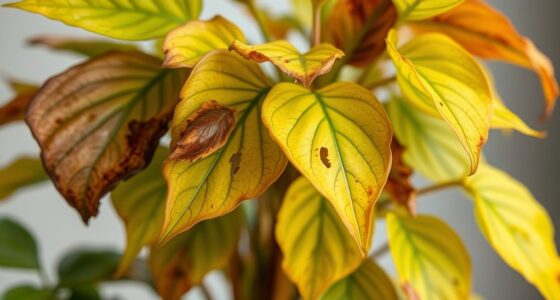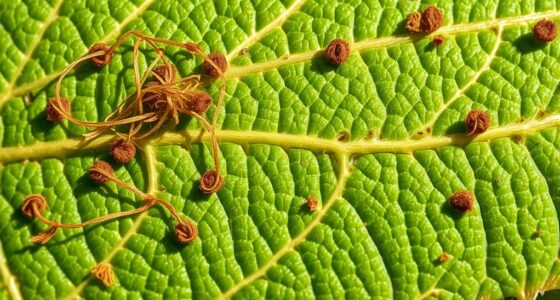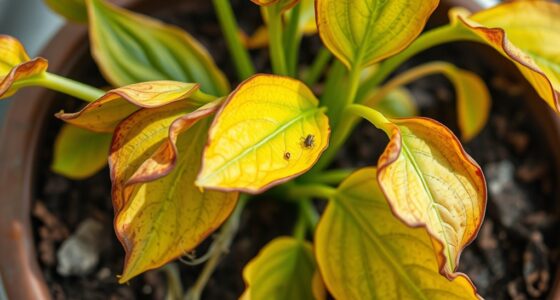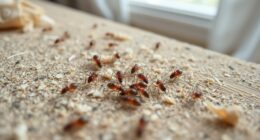If your plant shows yellowing or wilting leaves, it may be over or underwatered. Crispy or brown leaf edges often mean dehydration, while sticky residue or tiny bugs suggest pests. Wilting, discoloration, or physical damage are signs of trouble. Regularly check soil moisture and inspect leaves closely to catch issues early. Recognizing these clues helps you keep your plant healthy. Keep going to discover more tips for diagnosing and fixing common plant problems.
Key Takeaways
- Observe leaf color, wilting, or browning as signs of watering issues or nutrient deficiencies.
- Check for pests like tiny insects, webbing, or sticky residue indicating infestations.
- Feel soil moisture manually to identify overwatering or underwatering problems.
- Look for physical damage or unusual spots that suggest disease or pest damage.
- Regularly inspect plants for subtle changes to catch issues early and adjust care accordingly.
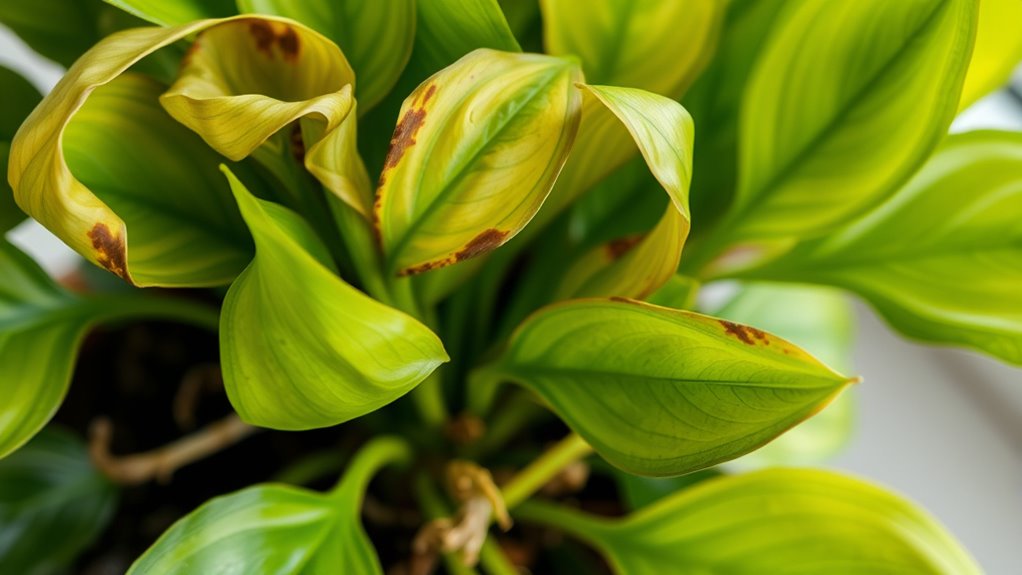
Have you ever wondered why your plant isn’t thriving despite your efforts? It can be frustrating to care for a plant that seems healthy one day and then suddenly shows signs of distress. Often, the root of the problem lies in simple issues like watering or pests. Addressing watering issues is a good starting point because both overwatering and underwatering can cause serious damage. If your plant’s leaves are yellowing or wilting, it might be because you’re watering too often or not enough. Overwatering leads to waterlogged soil, which suffocates roots and promotes root rot. Conversely, underwatering causes dehydration, making leaves crispy and brown. To diagnose watering issues, check the soil moisture by sticking your finger about an inch deep; if it feels wet, hold off on watering. If it’s dry, give your plant a thorough soak, ensuring excess water drains away. Adjust your watering schedule based on the plant’s needs, considering factors like pot size, type of soil, and indoor climate.
Pest identification is another essential step in diagnosing plant problems. Tiny insects or visible damage can point to a pest infestation, which can weaken or kill your plant if left unchecked. Look closely at the leaves, stems, and undersides for signs like sticky residue, webbing, holes, or small bugs. Common pests include aphids, spider mites, mealybugs, and scale insects. Each pest has distinct signs and often requires specific treatments. For example, if you notice a fine webbing, spider mites might be the culprit. If you see cottony masses on stems or leaves, mealybugs could be responsible. Identifying pests early is key; you can often remove them by hand or with a gentle stream of water. For more stubborn infestations, insecticidal soap or neem oil can help. Regular inspection and prompt treatment can prevent pests from spreading and causing further harm.
Understanding the signs your plant gives you and knowing how to identify watering issues and pests can make all the difference. By paying close attention to soil moisture levels and inspecting your plant regularly for pests, you can catch problems early and take corrective action. This proactive approach helps guarantee your plant gets the right care it needs to flourish. Remember, plants often show their distress through subtle changes—wilting, discoloration, or damage—so stay observant. With patience and careful diagnosis, you’ll be able to troubleshoot common issues and help your plant regain its health. Don’t get discouraged; each problem is a learning opportunity that brings you closer to becoming a confident, successful plant parent.
Frequently Asked Questions
How Often Should I Water My Indoor Plant?
You should water your indoor plant based on its specific watering schedule, which varies by species. Usually, check soil moisture by feeling the top inch; if it’s dry, it’s time to water. Avoid overwatering by allowing excess water to drain. Typically, most indoor plants need watering once a week, but always adjust for climate, pot size, and plant type to keep your plant healthy and thriving.
What’S the Ideal Sunlight for My Houseplant?
You should consider your houseplant’s light requirements and sun exposure to find the ideal sunlight. Most plants thrive with bright, indirect light, but some need direct sun for a few hours daily. Check your plant’s specific needs—some prefer low light, while others need full sun. Adjust its placement accordingly, ensuring it gets the right amount of light to stay healthy and vibrant, avoiding both too little and too much sun.
How Do I Prevent Pests From Attacking My Plant?
Imagine your plant’s health as a peaceful garden, free from unwelcome visitors. To keep pests at bay, regularly inspect your plant for pest identification, catching issues early. Use natural repellents like neem oil or garlic spray, which act as gentle guardians. Keep your plant healthy and clean, removing debris and dead leaves. This proactive approach creates a resilient environment, discouraging pests and nurturing your plant’s vibrant life.
When Should I Repot My Plant?
You should repot your plant when you notice slow growth or it becoming root bound. If roots are circling the pot’s edge or emerging from drainage holes, it’s time to upgrade to a larger container. Repotting encourages healthy plant growth by giving roots more space and fresh soil. Do this every 1-2 years, or when you see signs of overcrowding, to keep your plant thriving and healthy.
What Fertilizer Is Best for My Specific Plant Type?
Did you know that plants need 17 essential nutrients for healthy growth? For your specific plant, selecting the right fertilizer depends on its soil nutrition needs. Organic fertilizers like compost or fish emulsion boost soil health, while synthetic options such as balanced NPK fertilizers offer targeted nutrition. Always check your plant’s type and growth stage to choose the best fertilizer types, ensuring ideal health and vibrant growth.
Conclusion
Now that you’ve spotted the signs, your plant’s story isn’t over. Think of it as a delicate dance—you just need to tune into its rhythm and give it what it needs. With a little care and attention, you can turn those wilted leaves back into a lush, vibrant display. Like a gardener coaxing life from the earth, you hold the power to revive your plant’s spirit and watch it bloom once again.


